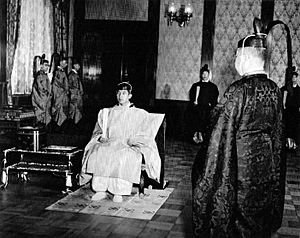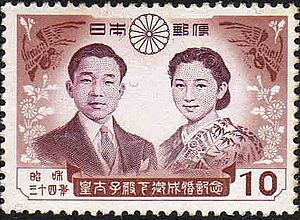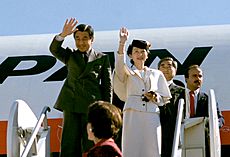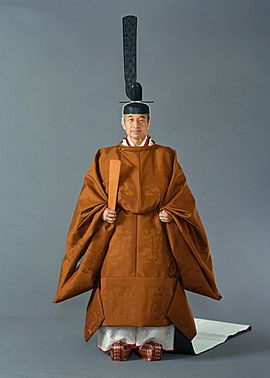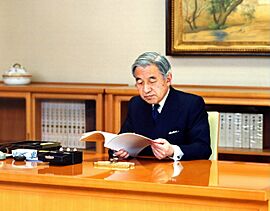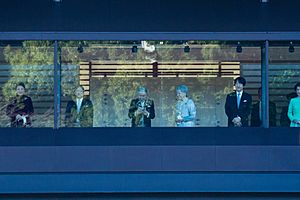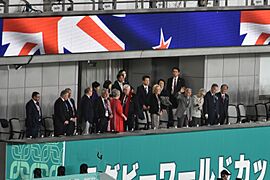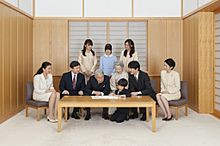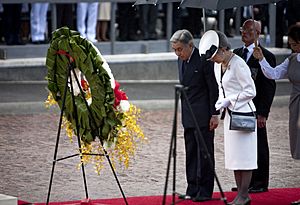Akihito facts for kids
Quick facts for kids Akihito
|
|||||
|---|---|---|---|---|---|
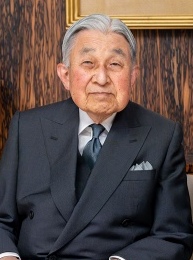
Akihito in 2024
|
|||||
| Emperor of Japan | |||||
| Reign | 7 January 1989 – 30 April 2019 | ||||
| Enthronement | 12 November 1990 | ||||
| Predecessor | Shōwa | ||||
| Successor | Naruhito | ||||
| Born | Akihito, Prince Tsugu (継宮明仁親王) 23 December 1933 Imperial Palace, Tokyo, Japan |
||||
| Spouse | |||||
| Issue |
|
||||
|
|||||
| House | Imperial House of Japan | ||||
| Father | Emperor Shōwa | ||||
| Mother | Princess Nagako Kuni | ||||
| Religion | Shinto | ||||
| Signature | |||||
Akihito (born 23 December 1933) is a member of the Imperial House of Japan. He was the 125th Emperor of Japan. He reigned from January 7, 1989, until he stepped down on April 30, 2019. His time as emperor was called the Heisei era, which means "achieving peace worldwide."
Akihito was the first son of Emperor Shōwa and Empress Kōjun. During World War II, he moved out of Tokyo for safety. In 1952, he became the crown prince. He started doing official duties for Japan. The next year, he traveled overseas for the first time. He represented Japan at the coronation of Elizabeth II in London. He finished his university studies in 1956.
In April 1959, he married Michiko Shōda. She was not from a royal family. This was the first imperial wedding shown on TV in Japan. About 15 million people watched it. Akihito and Michiko have three children: Naruhito, Fumihito, and Sayako.
Akihito became emperor after his father died in January 1989. His official ceremony was in 1990. He worked to bring the royal family closer to the Japanese people. He visited all 47 prefectures of Japan and many remote islands. He loves nature, conservation, and history. Akihito stepped down in 2019 because of his age and health. He then became known as the "Emperor Emeritus." His oldest son, Naruhito, became the next emperor. Akihito is the longest-living Japanese emperor in recorded history.
Contents
Akihito's Name and Title
During his time as emperor, Akihito was always called "His Majesty the Emperor." People did not use his personal name. His reign from 1989 to 2019 was known as the Heisei era. After he stepped down, he received the title of "Emperor Emeritus." This means "Retired Emperor."
Akihito's Early Life and School
Prince Akihito was born on December 23, 1933, in the Tokyo Imperial Palace. He was the fifth child and first son of Emperor Shōwa and Empress Kōjun. As a child, he was called Prince Tsugu. He had private teachers before going to the Peers' School from 1940 to 1952. Unlike past emperors, he did not become an army officer.
During World War II, Akihito and his younger brother, Prince Masahito, were moved out of Tokyo for safety. An American teacher, Elizabeth Gray Vining, taught Akihito English and Western customs. He later studied political science at Gakushuin University. He did not get a degree.
Akihito was the next in line to the throne from birth. His official ceremony to become crown prince was on November 10, 1952. In June 1953, he went to London. He represented Japan at the coronation of Queen Elizabeth II. This was his first trip outside Japan. He finished his university studies in 1956.
Akihito's Marriage and Family
In August 1957, Akihito met Michiko Shōda on a tennis court. At first, some people did not like their relationship. Michiko was not from a royal family. She had also been educated in a Catholic school.
The Imperial Household Council officially approved their engagement on November 27, 1958. Some traditional groups were against the marriage. This was because Michiko was from a Catholic family. Even though she was not baptized, she went to Catholic schools. It was the first time a common person married into the Imperial Family. This broke a tradition of over 2,600 years. Their engagement ceremony was on January 14, 1959. They married on April 10, 1959.
Akihito and Michiko have three children:
- Naruhito, born February 23, 1960.
- Fumihito, born November 30, 1965.
- Sayako, born April 18, 1969. After marrying Yoshiki Kuroda in 2005, she left the Imperial Family. She took her husband's last name.
As Crown Prince, Akihito wanted to bring the Imperial family closer to the people. He and Michiko visited 37 countries.
Akihito's Time as Emperor
Akihito became the 125th Emperor of Japan on January 7, 1989. He was 55 years old. His official ceremony was on November 12, 1990. In 1998, he visited the United Kingdom. He received the Order of the Garter.
After becoming emperor, he expressed sorrow to Asian countries. He apologized for their suffering during Japan's occupation. He started with an apology to China in April 1989.
In June 2005, the Emperor and Empress visited Saipan. This island was a battlefield in 1944 during World War II. Akihito prayed and placed flowers at memorials. He honored Japanese, American, Korean, and local people who died. This was the first time a Japanese emperor visited a World War II battlefield outside Japan. The Japanese people praised this trip. They also praised his visits to war memorials in Japan.
Akihito worked to bring the Imperial family closer to the Japanese people. He and Michiko visited 18 countries. They also visited all 47 Japanese prefectures. Akihito never visited Yasukuni Shrine. This was because it honors war criminals.
On September 6, 2006, his first grandson, Prince Hisahito, was born. This was important because he was the first male heir born to the Imperial family in 41 years. This helped solve a problem about who would be the next emperor.
After the 2011 Tōhoku earthquake and tsunami, the Emperor spoke on TV. This was a rare event. He told his people not to lose hope and to help each other.
Akihito's Role as Emperor
Under the Constitution of Japan, Akihito's role was mostly symbolic. He did not have real power in the government. He could not make political statements. He only acted in state matters as the Constitution allowed. Even then, he had to follow the advice of the Cabinet. For example, he formally appointed the Prime Minister. But he had to appoint the person chosen by the Diet (Japan's parliament).
Akihito Steps Down
On July 13, 2016, news reported that the 82-year-old Emperor wanted to abdicate (step down). He wanted his oldest son, Crown Prince Naruhito, to take over. An emperor had not stepped down since 1817. Stepping down required a change to the Imperial Household Law.
On August 8, 2016, the Emperor gave a rare TV speech. He talked about his old age and declining health. People understood this to mean he wanted to step down.
On May 19, 2017, a bill was created to allow Akihito to abdicate. The National Diet passed it on June 8, 2017. This law allowed the government to prepare for Naruhito to become emperor. Prime Minister Shinzo Abe announced that Akihito would step down on April 30, 2019. Naruhito became the 126th Emperor on May 1, 2019.
Akihito After Stepping Down
On March 19, 2020, Akihito and his wife moved out of the Imperial Palace. This was their first public appearance since he stepped down. They moved into the Takanawa Residence on March 31.
In December 2021, Akihito turned 88. This made him the longest-living Japanese emperor in history. His daily routine includes walks with his wife. He also reads and visits an imperial biology institute.
In August 2023, Akihito and Michiko visited the tennis court where they first met.
After Yuriko, Princess Mikasa passed away in November 2024, Akihito became the oldest living member of the Japanese imperial family.
Akihito's Health
Emperor Akihito had surgery for prostate cancer in January 2003. In 2011, he was in the hospital for pneumonia. In February 2012, he had heart bypass surgery. In July 2018, he felt sick due to not enough blood flow to his brain. In January 2020, he briefly lost consciousness. In July 2022, he was diagnosed with heart failure. In 2025, he was diagnosed with myocardial ischemia and supraventricular tachycardia.
Akihito's Children
Akihito and Michiko have two sons and one daughter.
| Name | Birth | Marriage | Children | |
|---|---|---|---|---|
| Date | Spouse | |||
| Naruhito, Emperor of Japan | 23 February 1960 | 9 June 1993 | Masako Owada | Aiko, Princess Toshi |
| Fumihito, Crown Prince of Japan | 30 November 1965 | 29 June 1990 | Kiko Kawashima |
|
| Sayako Kuroda | 18 April 1969 | 15 November 2005 | Yoshiki Kuroda | None |
Akihito's Research on Fish
Akihito is a published researcher who studies fish. He focuses on a fish family called Gobiidae. He has written articles for science journals. He also wrote about the history of science in Japan. In 2005, a new goby fish was named Exyrias akihito in his honor. In 2007, a group of gobies was named Akihito. In 2021, he discovered two new species of goby fish.
In 1965, Akihito sent 50 Nile tilapia fish to the King of Thailand. This was to help with food shortages. These fish have since become a major food source in Thailand.
- Member of the Ichthyological Society of Japan
- Honorary member of the Linnean Society of London (1986)
- Research associate of the Australian Museum
- Honorary member of the Zoological Society of London (1992)
- Honorary degree from Uppsala University (2007)
Akihito's Travels Abroad
The tables below show official visits made by Emperor Akihito and Empress Michiko.
Travels in the 1990s
| Dates | Location(s) | Details |
|---|---|---|
| 26 September – 6 October 1991 | Visited to build friendly relations. | |
| 23–28 October 1992 | China | Visited to build friendly relations. |
| 6–9 August 1993 | Belgium | Attended the funeral of King Baudouin of Belgium. |
| 3–19 September 1993 |
|
Visited to build friendly relations. |
| 10–26 June 1994 | United States | Visited to build friendly relations. |
| 2–14 October 1994 | Visited to build friendly relations. | |
| 30 May – 13 June 1997 | Visited to build friendly relations. | |
| 23 May – 5 June 1998 | Visited to build friendly relations. |
Travels in the 2000s
| Dates | Location(s) | Details |
|---|---|---|
| 20 May – 1 June 2000 | Visited to build friendly relations. | |
| 6–20 July 2002 | Visited to build friendly relations. | |
| 7–14 May 2005 | Norway | Visited to build friendly relations. |
| 27–28 June 2005 | United States | Attended events for the 60th anniversary of the end of World War II. |
| 8–15 June 2006 |
|
Celebrated 40 years of diplomatic ties between Japan and Singapore. Attended King Bhumibol Adulyadej's 60th anniversary celebration. |
| 21–30 May 2007 | Visited for a state visit and to mark a birth anniversary of Carl von Linné. | |
| 3–14 July 2009 | Canada | Visited to build friendly relations. |
| 15–17 July 2009 | United States | Visited Hawaii for the 50th anniversary of a scholarship foundation. |
Travels in the 2010s

| Dates | Location(s) | Details |
|---|---|---|
| 16–20 May 2012 | United Kingdom | Attended a lunch hosted by Queen Elizabeth II for her Diamond Jubilee. |
| 30 November – 6 December 2013 | India | Visited to build friendly relations. |
| 8–9 April 2015 | Palau | Attended events for the 70th anniversary of the end of World War II. |
| 26–30 January 2016 | Philippines | Visited to build friendly relations. Celebrated 60 years of diplomatic ties. |
| 28 February – 6 March 2017 | Vietnam | Visited to build friendly relations. |
| 5–6 March 2017 | Thailand | Met with King Vajiralongkorn and paid respects to the late King Bhumibol Adulyadej. |
See also
 In Spanish: Akihito para niños
In Spanish: Akihito para niños
- The Emperor's Birthday
- Imperial Household Agency
- Imperial House of Japan
- Japanese era name
- List of emperors of Japan



